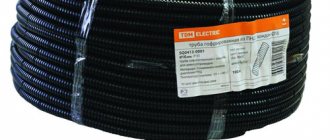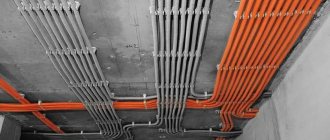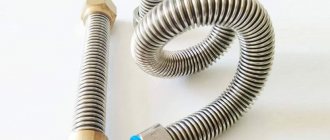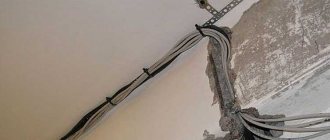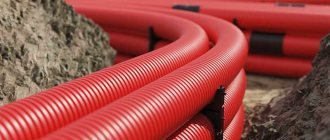Corrugated cable is a corrugated pipe with a variable cross-section, in which a large cross-section (thickened walls) alternates with a small cross-section (thin walls). For cable laying, pipes made of PVC (polyvinyl chloride), PPR (polypropylene) or HDPE (polyethylene) are usually used. The manufacturer places a broach in the pipe - a thin steel wire that allows you to tighten the cable into the pipe. This design ensures flexibility and strength of the pipe and trouble-free wiring. Corrugation is versatile, as it is suitable for various types of wires or cables, which provides reliable protection against mechanical damage and moisture. PVC corrugation also protects the wire from fire, since it has self-extinguishing properties. Due to the increased strength of the corrugated cable, it is widely used when laying communications in concrete, ground or outdoors: the polyethylene pipe is resistant to temperature changes and exposure to ultraviolet rays.
Why do you need a corrugated cable?
Due to its advantages, corrugated pipe is widely used in construction, plumbing and electrical work. Corrugated cable installation is most often carried out when conducting electrical wiring in plasterboard structures, as well as in floor screeds, in open space installation conditions and in industrial premises (garage, warehouse, shed, etc.). Corrugated pipe is also used during electrical installation work in wooden houses. The corrugated pipe provides reliable protection of the electrical cable from mechanical, thermal influences, precipitation and ultraviolet radiation.
Lay corrugation along the wall and floor
Many people are probably interested in how corrugated pipes are connected to distribution boxes. We weren’t going to get away with general phrases, listen!
- Individual pieces of corrugation are joined using couplings (price is about three rubles per piece). Use the products offered by the manufacturer. There are many ways to connect the coupling and corrugation. If there are no cable connections in a given area of the site, it is possible to seal the joints with sealant.
- There is a steel broach inside the expensive corrugated models. Pipes for laying wiring in the apartment are used as efficiently as possible: a channel is made in the wall (on the surface), and according to the electrical diagram, the required number of wires is pulled inside.
- The corrugation is attached to the wall with specially shaped anchors. Installation on brackets made of metal packaging tape, which is pressed onto dowel-nails, is allowed.
- As for the accumulation of water inside the corrugation, the forums are full of the topic. The legislative part of PUE 6, which we are considering today, has not been adopted. If you are building for yourself, it is more important to feel confident in the quality than to comply with the letter of the law. In dry rooms, it is allowed to use corrugated joints without compaction or sealing.
- The cable is laid through a corrugated wall through a special sleeve, selected in diameter. The passage is sealed if necessary.
The turn is performed by bending the route with a radius higher than that allowed for the bundle cable brands. Similar parameters are often indicated for corrugation
Please note that if it is necessary to replace part of the cores, problems may arise. When rounding the corrugation, be careful not to bend it
Otherwise, the requirement for filling the section (35%) will be violated. In the attic, the height of the cable on the wall is not standardized when using any corrugation. However, the requirements listed above are met.
Indoors, it is practiced to lay cable ducts along the walls, because the technique looks elegant. And in basements and attics, corrugation is appropriate due to its excellent insulating properties.
What type of cable corrugation is there?
Corrugations for cables and electrical wires are most often made of plastic and metal. Plastic corrugated pipe has excellent electrical insulating properties, which eliminates the need for grounding, low weight and plasticity. The flexibility of the pipe allows you to lay curved routes without additional rotating elements, and due to the durability of the plastic, additional protection is not required, like metal pipes.
Platinum corrugation can be polypropylene (PPR), the color of such corrugation is usually blue, the material has a self-extinguishing property, it does not support combustion. Corrugated polypropylene is highly water resistant, so it can be used for laying cables outdoors or in rooms with high humidity. Designed for laying electrical, telephone, computer, television networks operating under direct or alternating current electrical voltage, made with insulated wires, cords or cables.
Corrugation for cable made of PVC, polyvinyl chloride, gray in color, also has a self-extinguishing property, which prevents the spread of fire, it can be used on low-flammable substrates when installing open wiring in the case of using cable and wire products with the index “ng”, but is not water resistant , is used only in dry rooms.
On a wooden floor
Laying in the structure of wooden floors is complicated by the fact that it is carried out in a fire hazardous environment. Taking into account this feature, cable products whose shells do not propagate fire should be used for installation. The best according to this criterion are cables whose letter part of the brand is supplemented with the symbols “ng” - non-flammable.
The best results are obtained by using metal pipes, which also protect against mechanical damage. A blind metal tray is also acceptable.
The formation of a cable channel system is performed in the following sequence:
- First, pipe laying routes are formed. To pass through the logs, technological holes are made in them, which can be replaced with cuts
- Metal pipes of individual channels are installed according to the design, followed by fastening to the transverse beams. The main means of fastening pipes is perforated tape; self-tapping screws are used for fixation.
- If there is a large gap in the places where the beams pass through, it is sealed with polyurethane foam.
- Individual sections of pipes are connected to each other through junction boxes. An example of such a connection is shown in Figure 8.
- Regardless of the type of metal pipe, they must be grounded to form channels.
- Power cables are pulled into the formed tubular channels.
When cable ducts pass through wooden structures, the use of protective sleeves and short sections of pipes is not mandatory.
When using a system for underground laying of electrical cables, taking into account the high fire hazard of wooden structures, it is necessary to additionally treat them with fire retardant compounds.
An example of installing a junction box with grounding of pipes and foaming of mounting cuts in joists.
Laying cables in the floor has a number of advantages, but due to certain technological difficulties in implementation, it is advisable to use it in the process of new construction of city apartments. For wooden houses, this limitation shifts to the level of major repairs.
In the process of forming the wiring, it is advisable to provide a system of mounting boxes, and the pipes between the individual boxes should have a minimum number of turns. The process of forming electrical wiring using a gasket in the floor is not highly technologically complex; with the use of modern building materials, it can be performed without outside help with initial qualifications and without the use of special tools.
What kind of cable is pulled into the corrugation?
The main requirement for the cable is that its winding must be made of non-flammable material (marking ng-Ls). High-quality PVC film has a fairly high fire safety rating, which means that sparking wiring is unlikely to cause a fire. But if the wiring gets very hot or sparks for a long enough time, holes can melt in the film and the cable will smoke the entire room. Only low-quality Chinese film can break out and start a fire. Products of European brands that have the appropriate certificates have a tendency to self-extinguish, so they will not be able to maintain combustion. It is also important to consider the power and load on the corrugated cable.
Table of correspondence between the sizes of VVG cable and corrugated pipes, rigid pipes, metal hoses.
| Cable name | Rigid pipe | Metalsleeve | Corrugated pipe |
| Cable VVG 2x1.5 | Rigid pipe 20 | Metal hose 15 | PVC corrugated pipe 20 |
| Cable VVG 2x2.5 | Rigid pipe 20 | Metal hose 18 | PVC corrugated pipe 25 |
| Cable VVG 2x4 | Rigid pipe 25 | Metal hose 25 | PVC corrugated pipe 32 |
| Cable VVG 2x6 | Rigid pipe 25 | Metal hose 25 | PVC corrugated pipe 32 |
| Cable VVG 2x10 | Rigid pipe 32 | Metal hose 25 | PVC corrugated pipe 32 |
| Cable VVG 3x1.5 | Rigid pipe 20 | Metal hose 15 | PVC corrugated pipe 20 |
| Cable BBГ 3x2.5 | Rigid pipe 20 | Metal hose 18 | PVC corrugated pipe 25 |
| Cable VVG 3x4 | Rigid pipe 25 | Metal hose 25 | PVC corrugated pipe 32 |
| Cable VVG 3x6 | Rigid pipe 25 | Metal hose 25 | PVC corrugated pipe 32 |
| Cable VVG 3x10 | Rigid pipe 32 | Metal hose 32 | PVC corrugated pipe 40 |
| Cable VVG 4x1.5 | Rigid pipe 20 | Metal hose 18 | PVC corrugated pipe 25 |
| Cable VVG 4x2.5 | Rigid pipe 25 | Metal hose 18 | PVC corrugated pipe 25 |
| Cable VVG 4x4 | Rigid pipe 25 | Metal hose 25 | PVC corrugated pipe 32 |
| Cable VVG 4x6 | Rigid pipe 32 | Metal hose 25 | PVC corrugated pipe 32 |
| Cable VVG 4x10 | Rigid pipe 32 | Metal hose 32 | PVC corrugated pipe 40 |
| Cable VVG 4x16 | Rigid pipe 40 | Metal hose 38 | Corrugated pipe PVC 50 |
| Cable VVG 4x25 | Rigid pipe 50 | Metal hose 50 | |
| Cable VVG 4x35 | Rigid pipe 63 | Metal hose 50 | |
| Cable VVG 4x50 | Rigid pipe 63 | Metal hose 63 | |
| Cable VVG 5x1.5 | Rigid pipe 25 | Metal hose 18 | PVC corrugated pipe 25 |
| Cable VVG 5x2.5 | Rigid pipe 25 | Metal hose 25 | PVC corrugated pipe 32 |
| Cable VVG 5x4 | Rigid pipe 25 | Metal hose 25 | PVC corrugated pipe 32 |
| Cable VVG 5x6 | Rigid pipe 32 | Metal hose 32 | PVC corrugated pipe 40 |
| Cable VVG 5x10 | Rigid pipe 40 | Metal hose 38 | Corrugated pipe PVC 50 |
| Cable VVG 5x16 | Rigid pipe 50 | Metal hose 50 | Corrugated pipe PVC 50 |
| Cable VVG 5x25 | Rigid pipe 50 | Metal hose 50 | |
| Cable VVG 5x35 | Rigid pipe 63 | Metal hose 63 | |
| Cable VVG 5x50 | Rigid pipe 63 | Metal hose 80 |
Table of correspondence between the sizes of AVVG cable and corrugated pipes, rigid pipes, metal hoses.
| Cable name | Rigid pipe | Metalsleeve | Corrugated pipe |
| Cable AVVG 2x2.5 | Rigid pipe 20 | Metal hose 18 | PVC corrugated pipe 25 |
| Cable AVVG 2x4 | Rigid pipe 20 | Metal hose 18 | PVC corrugated pipe 25 |
| Cable AVVG 2x6 | Rigid pipe 25 | Metal hose 25 | PVC corrugated pipe 32 |
| Cable AVVG 2x10 | Rigid pipe 32 | Metal hose 25 | PVC corrugated pipe 32 |
| Cable AVVG 2x16 | Rigid pipe 32 | Metal hose 32 | PVC corrugated pipe 40 |
| Cable AVVG 3x2.5 | Rigid pipe 20 | Metal hose 18 | PVC corrugated pipe 25 |
| Cable AVVG 3x4 | Rigid pipe 25 | Metal hose 18 | PVC corrugated pipe 25 |
| Cable AVVG 3x6 | Rigid pipe 25 | Metal hose 25 | PVC corrugated pipe 32 |
| Cable AVVG 3x10 | Rigid pipe 32 | Metal hose 25 | PVC corrugated pipe 32 |
| Cable AVVG 3x16 | Rigid pipe 40 | Metal hose 38 | Corrugated pipe PVC 50 |
| Cable AVVG 3x4+1x2.5 | Rigid pipe 25 | Metal hose 25 | PVC corrugated pipe 32 |
| Cable AVVG 3x6+1x4 | Rigid pipe 25 | Metal hose 25 | PVC corrugated pipe 32 |
| Cable AVVG 3x10+1x6 | Rigid pipe 32 | Metal hose 32 | PVC corrugated pipe 40 |
| Cable AVVG 3x16+1x10 | Rigid pipe 40 | Metal hose 32 | PVC corrugated pipe 40 |
| Cable AVVG 3x25+1x16 | Rigid pipe 50 | Metal hose 38 | Corrugated pipe PVC 50 |
| Cable AVVG 3x35+1x16 | Rigid pipe 50 | Metal hose 50 | |
| Cable AVVG 3x50+1x25 | Rigid pipe 63 | Metal hose 50 | |
| Cable AVVG 3x70+1x35 | Rigid pipe 63 | Metal hose 63 | |
| Cable AVVG 3x95+1x50 | Metal hose 63 | ||
| Cable AVVG 3x120+1x70 | Metal hose 80 | ||
| Cable AVVG 4x2.5 | Rigid pipe 25 | Metal hose 18 | PVC corrugated pipe 25 |
| Cable AVVG 4x4 | Rigid pipe 25 | Metal hose 25 | PVC corrugated pipe 32 |
| Cable AVVG 4x6 | Rigid pipe 25 | Metal hose 25 | PVC corrugated pipe 32 |
| Cable AVVG 4x10 | Rigid pipe 32 | Metal hose 32 | PVC corrugated pipe 40 |
| Cable AVVG 4x16 | Rigid pipe 40 | Metal hose 32 | PVC corrugated pipe 40 |
| Cable AVVG 4x25 | Rigid pipe 40 | Metal hose 38 | Corrugated pipe PVC 50 |
| Cable AVVG 4x35 | Rigid pipe 50 | Metal hose 50 | |
| Cable AVVG 4x50 | Rigid pipe 63 | Metal hose 63 | |
| Cable AVVG 4x70 | Rigid pipe 63 | Metal hose 63 | |
| Cable AVVG 4x95 | Metal hose 80 | ||
| Cable AVVG 4x120 | Metal hose 80 |
Table of correspondence between the sizes of PVA wire and corrugated pipes, rigid pipes, metal hoses.
| Cable name | Rigid pipe | Metalsleeve | Corrugated pipe |
| Wire PVS 2x0.5 | Rigid pipe 16 | Metal sleeve 10 | PVC corrugated pipe 16 |
| Wire PVS 2x0.75 | Rigid pipe 16 | Metal hose 12 | PVC corrugated pipe 16 |
| PVS wire 2x1 | Rigid pipe 16 | Metal hose 12 | PVC corrugated pipe 20 |
| Wire PVS 2x1.5 | Rigid pipe 16 | Metal hose 15 | PVC corrugated pipe 20 |
| Wire PVS 2x2.5 | Rigid pipe 20 | Metal hose 18 | PVC corrugated pipe 25 |
| PVS wire 2x4 | Rigid pipe 25 | Metal hose 25 | PVC corrugated pipe 32 |
| PVS wire 2x6 | Rigid pipe 25 | Metal hose 25 | PVC corrugated pipe 32 |
| Wire PVS 3x0.5 | Rigid pipe 16 | Metal hose 12 | PVC corrugated pipe 16 |
| Wire PVS 3x0.75 | Rigid pipe 16 | Metal hose 12 | PVC corrugated pipe 20 |
| Wire PVS 3x1 | Rigid pipe 16 | Metal hose 12 | PVC corrugated pipe 20 |
| Wire PVS 3x1.5 | Rigid pipe 20 | Metal hose 15 | PVC corrugated pipe 20 |
| Wire PVS 3x2.5 | Rigid pipe 20 | Metal hose 18 | PVC corrugated pipe 25 |
| PVS wire 3x4 | Rigid pipe 25 | Metal hose 25 | PVC corrugated pipe 32 |
| PVS wire 3x6 | Rigid pipe 32 | Metal hose 25 | PVC corrugated pipe 32 |
| Wire PVS 4x0.5 | Rigid pipe 16 | Metal sleeve 10 | PVC corrugated pipe 16 |
| Wire PVS 4x0.75 | Rigid pipe 16 | Metal hose 12 | PVC corrugated pipe 16 |
| Wire PVS 4x1 | Rigid pipe 16 | Metal hose 12 | PVC corrugated pipe 20 |
| Wire PVS 4x1.5 | Rigid pipe 20 | Metal hose 15 | PVC corrugated pipe 20 |
| Wire PVS 4x2.5 | Rigid pipe 20 | Metal hose 18 | PVC corrugated pipe 25 |
| PVS wire 4x4 | Rigid pipe 25 | Metal hose 25 | PVC corrugated pipe 32 |
| PVS wire 4x6 | Rigid pipe 32 | Metal hose 25 | PVC corrugated pipe 32 |
| Wire PVS 5x0.5 | Rigid pipe 16 | Metal hose 12 | PVC corrugated pipe 16 |
| Wire PVS 5x0.75 | Rigid pipe 16 | Metal hose 12 | PVC corrugated pipe 20 |
| Wire PVS 5x1 | Rigid pipe 16 | Metal hose 12 | PVC corrugated pipe 20 |
| Wire PVS 5x1.5 | Rigid pipe 20 | Metal hose 15 | PVC corrugated pipe 20 |
| Wire PVS 5x2.5 | Rigid pipe 20 | Metal hose 18 | PVC corrugated pipe 25 |
| PVS wire 5x4 | Rigid pipe 25 | Metal hose 25 | PVC corrugated pipe 32 |
| PVS wire 5x6 | Rigid pipe 32 | Metal hose 25 | PVC corrugated pipe 32 |
Table of correspondence between the sizes of ball screw wires and corrugated pipes, rigid pipes, metal hoses.
| Cable name | Rigid pipe | Metalsleeve | Corrugated pipe |
| Wire SHVVP 2x0.5 | Rigid pipe 16 | Metal sleeve 10 | PVC corrugated pipe 16 |
| Wire SHVVP 2x0.75 | Rigid pipe 16 | Metal sleeve 10 | PVC corrugated pipe 16 |
| Wire SHVVP 2x1 | Rigid pipe 16 | Metal sleeve 10 | PVC corrugated pipe 16 |
| Wire SHVVP 2x1.5 | Rigid pipe 16 | Metal hose 12 | PVC corrugated pipe 20 |
| Wire SHVVP 2x2.5 | Rigid pipe 16 | Metal hose 15 | PVC corrugated pipe 20 |
| ShVVP wire 2x4 | Rigid pipe 20 | Metal hose 15 | PVC corrugated pipe 25 |
| Wire SHVVP 2x6 | Rigid pipe 25 | Metal hose 18 | PVC corrugated pipe 25 |
| Wire SHVVP 3x0.5 | Rigid pipe 16 | Metal sleeve 10 | PVC corrugated pipe 16 |
| Wire SHVVP 3x0.75 | Rigid pipe 16 | Metal hose 12 | PVC corrugated pipe 16 |
| Wire SHVVP 3x1 | Rigid pipe 16 | Metal hose 12 | PVC corrugated pipe 20 |
| Wire SHVVP 3x1.5 | Rigid pipe 16 | Metal hose 15 | PVC corrugated pipe 20 |
| Wire SHVVP 3x2.5 | Rigid pipe 20 | Metal hose 15 | PVC corrugated pipe 25 |
| Wire SHVVP 3x4 | Rigid pipe 20 | Metal hose 18 | PVC corrugated pipe 25 |
| Wire SHVVP 3x6 | Rigid pipe 25 | Metal hose 25 | PVC corrugated pipe 32 |
Attaching the cable channel to the wall
You can fasten the cable channel to the wall using dowel nails (if the walls are concrete or brick) or ordinary screws (if the walls are wooden). This is a more reliable way. The cable channel is mounted to plasterboard partitions or cladding using special butterfly dowels. If the cable passes through turns of partitions or arches, several parallel cuts are made on the walls of the casing in order to then bend it into the desired plane. The covers are also cut in the same way where it is necessary to bend the cable channel at an angle. Using a similar scheme, fastenings for cable channels are installed on walls and ceilings.
If the box is small, dowel nails or screws are screwed into the middle. If the width of the casing back is more than 50 mm, the fasteners must grip it along the edges.
To accurately fit the accessories, the cable channel begins to be laid from the entrance to the room and sequentially leads to all electrical points. After the box is installed, the cable is laid in it. Some enclosures have special partitions to separate the wires. This is especially convenient when information and power cables are placed in one box. The box is mounted, leaving a small gap between the wires. Do not lay the wires so that the box lid does not close. It is better to immediately take a larger cable channel. Having completed laying the cable, put a cover on the box: just insert it into the grooves and press until it clicks.
How many cables can be pulled into one corrugation?
It all depends on the diameter of the corrugated pipe. An approximate calculation of how many cables can be laid in one corrugation: with a diameter of 16, 3 cables will fit, if it is 20, 4-5 will fit, and with a diameter of more than 25, 5-6 cables will fit.
The exact quantity is calculated provided that the pipe length is at least 35 meters.
Advantages of using ultrasonic microscopy mini
Mini-narrow cable pulling machines are used by installers and professional builders when pulling various types of cables through channels, pipes, ducts and metal sleeves during the installation of SCS communications, electrical wiring, and fiber-optic lines. The devices are used during the installation of security alarms, video and audio systems, and intercoms. The package includes a threaded nozzle, a wear-resistant fiberglass rod and a transport and operating trolley. The elastic rod can self-align in a free position. You can attach a rotation compensator, guide heads, connecting tube, and tips with an eye to the threaded tips.
Product advantages:
- light weight;
- simple design;
- rod flexibility;
- wear resistance;
- small dimensions.
For comfortable work with ultrasonic testing, various consumables are used - lubricants, cable stockings for effective cable grip and other devices. Lubricants help reduce friction by up to 90%.
How to pull a cable through a corrugation manually?
If you are running a cable through a corrugated pipe for the first time, it can be difficult to understand how to correctly route the wire through a corrugated pipe for electrical wiring. Below is an algorithm that will help you cope with this task. First you need to measure the required length and cut the pipe, then cut the wire with side cutters. Next, you should hold the broach so that it does not get lost in the pipe, and make a tight bundle. The harness inserted into the corrugation must be attached to a metal broach, and the joints must be wrapped with insulating tape.
After placing the wiring, the corrugated pipe is fixed every 20 cm with special fasteners. The clamps are first attached to the corrugation, and then to the surface. A special device is used to pull the cable through the corrugation.
Installation of wire in a screed
Well, at the last stage, let's look at the installation itself.
It is not so complicated and can easily be done with your own hands, but we need to pay attention to some nuances
We make walls for embedded boxes
First of all, we are building walls to install embedded parts for sockets, switches and wiring to them. After all, these devices cannot be placed close to the floor. In this case, the groove should be of such a depth that the wire fits in the corrugation, and then the putty layer should be at least 1 cm.
Pulling wires in a corrugated
The next step is to lay the corrugation. It is better to lay the corrugation with the wires already stretched, although this can be done later. When laying corrugations, we try to eliminate their intersection and get rid of sharp corners. This will make it easier for you to change the wire if necessary.
We try to avoid intersection of corrugated hoses
After this, we connect all electrical points. It is mandatory to check their functionality with voltage applied. Ideally, even turn on all electrical points for a day, and then see if we have heating anywhere.
We fix the corrugation to the floor
- If we used plastic corrugation, then we fix it to the floor. This is necessary in case it starts to float while pouring the screed. This practically does not happen with metal corrugation, but it is better to secure it in the same way as in the video.
- Well, at the very last stage we directly fill the floor. In this case, it is better to remove the voltage from all wires in this room. The screed must provide at least a 3 cm layer above the corrugation. The functionality of the network should be checked only after the concrete has completely dried, which is 15–30 days.
Errors when tightening cables into corrugations
The most common mistakes made when laying cable networks stretched inside the corrugation are the following.
- Creating sharp corners. It is necessary to lay the routes in such a way that the corner transitions are flexible; sharp corners should not be allowed at turns, this will lead to damage to the corrugated pipe and cable.
- No special components are used to increase the length. When you need to make an entire section of wiring longer, you need to use tees, transit boxes and couplings.
- The corrugation is connected using electrical tape. According to the PUE, it is unacceptable to connect 2 corrugated pipes with each other using insulating tape; there are connecting components for this. This applies to turns, corners, and the middle of a long section.
- One corrugation has been laid, into which several lines of power cables are stretched. According to the PUE, it is correct when each cable power line is pulled into a separate corrugated pipe. It is unacceptable to lay several conductors in a corrugated cable at once.
Non-standard situations
The most common non-standard situation is that when pulling a string, it is torn off from the conductor due to strong tension. In this case, you need to cut off the part of the corrugation that has already been threaded and leave it. After this, you should reconnect the wire to the end of the cable and finish pulling. Two pieces of corrugated pipe should be connected using electrical tape.
Pulling the wire through the corrugation, if there is no broach, will also not be difficult. It will be enough to simply bend the end of the conductor 180 degrees. After this, you can push the product through the entire lower length. This technology can be seen in the video below:
If there is not enough space in your apartment and you need to thread a long section of corrugated pipe yourself, for example, 30 meters, then you should do it in the room. In this case, the cable must be connected to the string. After this, you can leave the entrance and fasten the free end of the wire to the railing on the top floor. After this, you need to stretch the corrugation until the problem is solved.
Sometimes it may also be necessary to run a conductor in a corrugated hose along the ceiling. This process is quite difficult to carry out, and if the sheets are already sewn up, then the installation must be done through grooves. In this case, a regular pipe will help to insert the corrugated pipe through the ceiling. In the video below you can see all stages of the work.
The latter situation includes laying a cable with rubber insulation in a corrugated area. The main difficulty will be that when pulling, strong friction occurs between the walls of the corrugated pipe. As a result, even wire will not be able to facilitate the process, since there is no broaching. In this case, a special lubricant will come to your aid, with which you can quickly pull the cable through the corrugated pipe. The cost of this lubricant is considered quite high, but if you often perform electrical work, then we recommend purchasing it.
This is all the information we wanted to provide in this article. Now you know how to pull the cable into the corrugation with your own hands if there is no pull-through.



